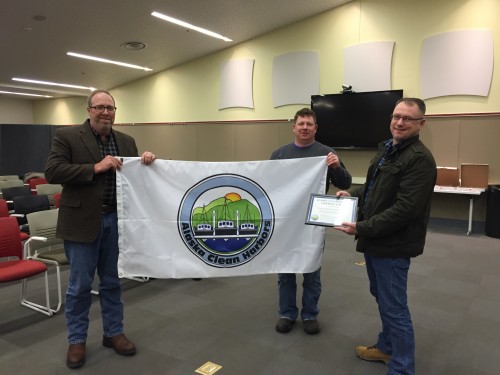Sitka is the fourth recipient of a statewide “Alaskan Clean Harbors” certificate. Along with Homer, Seward, and Haines, Sitka’s harbor system was recognized in October by the Alaska Clean Harbors Advisory Committee for meeting 88 best management practices.

The Alaska Clean Harbors checklist of best management practices – or BMPs – is like the boating world’s version of eating your broccoli. The BMPs are designed to prevent pollution, reduce waste, save costs – basically to encourage clean boating. And Sitka has won the equivalent of a clean plate award.
Here is the checklist: ACH-BMP-Checklist-v.2010
Brett Farrell, Assistant Director of the Marine Exchange of Alaska, came to Sitka’s Assembly meeting last Tuesday (12-08-15) to recognize the harbors system.
“Sitka is now a leader in Alaska for proactive pollution prevention practices,” he said. “Your harbor department is not only complying with local, state, and federal regulations, but going above and beyond to provide services to harbor customers that make doing the right thing reasonable and attractive alternatives to often polluting activities that constitute business as usual in many harbors.”
Farrell then presented a certificate and a white flag – emblazoned with three fishing boats moored in clear blue waters. Accepting the flag was Harbormaster Stan Eliason and Deputy Harbormaster Chuck Hackett.
Eliason says that, in order for qualify as an Alaskan Clean Harbor, the Sitka harbor system had to meet 100 percent of state and federal legal requirements and 80 percent of the BMPs.
One of the biggest improvements is the installation of new signs spelling out proper waste disposal.
“You’ll see a lot of signage throughout the harbor systems and all the gangways and stuff – basically telling people who to call if they see an oil spill. Dos and donts and that kind of stuff,” Eliason explained. “And we’ll have a pamphlet here at the office to give out to the general public that maps out where you can find our recyclables, waste bins, what to do with batteries, et cetera.”
Eliason says all the public literature was paid for by the ACH Advisory Committee, which is run by volunteers across the state to help communities implement these regulations and BMPs. On the phone with KCAW, Eliason thanked Hackett and maintenance supervisor Ron Pratt, for taking the lead on the project.
Eliason: Yeah, we’re quite happy. Move on to the next thing I guess.—
KCAW: What is the next thing?
Eliason: I’m waiting for it. There’s always a challenge out there.
Among them, Eliason says, is tracking down a flagpole.




